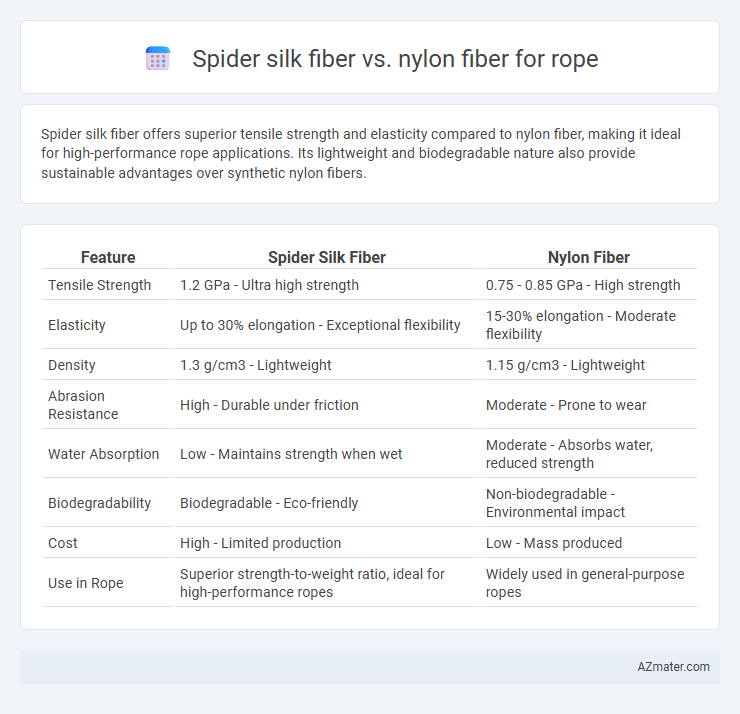Spider silk fiber offers superior tensile strength and elasticity compared to nylon fiber, making it ideal for high-performance rope applications. Its lightweight and biodegradable nature also provide sustainable advantages over synthetic nylon fibers.
Table of Comparison
| Feature | Spider Silk Fiber | Nylon Fiber |
|---|---|---|
| Tensile Strength | 1.2 GPa - Ultra high strength | 0.75 - 0.85 GPa - High strength |
| Elasticity | Up to 30% elongation - Exceptional flexibility | 15-30% elongation - Moderate flexibility |
| Density | 1.3 g/cm3 - Lightweight | 1.15 g/cm3 - Lightweight |
| Abrasion Resistance | High - Durable under friction | Moderate - Prone to wear |
| Water Absorption | Low - Maintains strength when wet | Moderate - Absorbs water, reduced strength |
| Biodegradability | Biodegradable - Eco-friendly | Non-biodegradable - Environmental impact |
| Cost | High - Limited production | Low - Mass produced |
| Use in Rope | Superior strength-to-weight ratio, ideal for high-performance ropes | Widely used in general-purpose ropes |
Introduction to Spider Silk and Nylon Fibers
Spider silk fiber exhibits exceptional tensile strength, elasticity, and biodegradability, making it an innovative material for rope manufacturing. Nylon fiber, a synthetic polymer, offers high durability, resistance to abrasion, and moisture absorption, leading to widespread use in industrial and recreational ropes. Comparing these fibers highlights spider silk's natural strength-to-weight ratio versus nylon's cost-effectiveness and scalability in production.
Historical Development and Usage
Spider silk fiber, renowned for its exceptional tensile strength and elasticity, has a rich history dating back to ancient civilizations that valued it for lightweight, durable textiles and bindings. Nylon fiber, developed in 1935 by Wallace Carothers at DuPont, revolutionized rope manufacturing with its synthetic consistency, resistance to abrasion, and cost-effective large-scale production, leading to widespread industrial and military applications. While spider silk remains primarily experimental due to harvesting challenges, nylon dominates the modern rope market, combining durability and affordability.
Structural Composition of Spider Silk vs Nylon
Spider silk fiber consists primarily of protein polymers called fibroins, which form highly ordered b-sheet crystalline regions interspersed with amorphous matrix, providing a unique combination of elasticity and tensile strength. Nylon fiber is a synthetic polyamide composed of long chains of repeating amide linkages (-CONH-) that form semicrystalline structures, contributing to its high durability and resistance to abrasion. The hierarchical molecular arrangement in spider silk offers superior toughness and energy absorption compared to the more uniform, synthetic polymer structure of nylon fibers used in rope manufacturing.
Mechanical Strength and Durability Comparison
Spider silk fiber exhibits remarkable mechanical strength, with tensile strength often exceeding 1.1 GPa, surpassing many synthetic fibers including nylon, which typically has tensile strength around 0.7 GPa. The elasticity of spider silk, with strain at break reaching up to 30%, provides superior toughness and flexibility compared to nylon's strain around 20%, enhancing its durability under dynamic loads. Spider silk's natural resilience to environmental degradation, such as UV exposure and moisture, contributes to longer-lasting rope performance, while nylon fibers can degrade faster under similar conditions, requiring more frequent replacement.
Flexibility and Elasticity Analysis
Spider silk fiber exhibits superior flexibility compared to nylon fiber, allowing ropes made from spider silk to bend and twist without losing structural integrity. Its elasticity is remarkable, stretching up to 30% of its original length while maintaining tensile strength, whereas nylon fibers typically stretch between 15-20%. This enhanced elasticity and flexibility make spider silk composite ropes ideal for dynamic loads and impact absorption in climbing and rescue operations.
Environmental Impact and Sustainability
Spider silk fiber exhibits superior environmental sustainability compared to nylon fiber due to its biodegradability and production from renewable biological sources, minimizing ecological footprint. Nylon fiber, derived from petrochemicals, contributes to environmental pollution through greenhouse gas emissions and persistent microplastic waste during degradation. Utilizing spider silk for rope applications significantly reduces reliance on fossil fuels and mitigates long-term environmental impact associated with synthetic polymer disposal.
Production Methods and Scalability
Spider silk fiber is produced naturally by spiders through protein spinning but faces significant scalability challenges due to the complexity of spider farming and silk harvesting. Nylon fiber is synthetically manufactured through petrochemical polymerization processes, enabling large-scale production with consistent quality and lower cost. Industrial scalability and reliable mass production make nylon the predominant choice for rope manufacturing despite spider silk's superior strength-to-weight ratio.
Cost Efficiency and Commercial Availability
Spider silk fiber offers exceptional tensile strength and elasticity, making it ideal for high-performance ropes, but its high production costs and limited commercial availability hinder widespread use. Nylon fiber is economically produced at scale with consistent quality, providing cost-efficient and readily accessible material for rope manufacturing. The established supply chain and lower price point of nylon fibers make them the preferred choice for most commercial rope applications.
Applications in Rope Manufacturing
Spider silk fiber offers superior tensile strength, elasticity, and biodegradability, making it ideal for high-performance ropes used in climbing, search and rescue, and military applications. Nylon fiber remains popular for rope manufacturing due to its durability, abrasion resistance, and cost-effectiveness in industrial, marine, and general utility ropes. Innovations in blending spider silk with nylon aim to combine the natural strength and flexibility of spider silk with the resilience and affordability of nylon for advanced rope solutions.
Future Prospects and Innovations
Spider silk fiber offers exceptional tensile strength, elasticity, and biodegradability, making it a promising sustainable alternative to nylon fiber in rope manufacturing. Innovations in bioengineering and synthetic biology aim to mass-produce spider silk proteins, enhancing scalability and cost-efficiency compared to traditional nylon fibers derived from petrochemicals. Future prospects include developing hybrid ropes combining spider silk's lightweight, high-performance properties with nylon's durability, optimizing applications in aerospace, military, and medical fields.

Infographic: Spider silk fiber vs Nylon fiber for Rope
 azmater.com
azmater.com